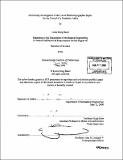| dc.contributor.advisor | Hugh Herr. | en_US |
| dc.contributor.author | Basel, Louis Hong | en_US |
| dc.contributor.other | Massachusetts Institute of Technology. Dept. of Mechanical Engineering. | en_US |
| dc.date.accessioned | 2007-02-21T13:23:54Z | |
| dc.date.available | 2007-02-21T13:23:54Z | |
| dc.date.issued | 2006 | en_US |
| dc.identifier.uri | http://hdl.handle.net/1721.1/36297 | |
| dc.description | Thesis (S.B.)--Massachusetts Institute of Technology, Dept. of Mechanical Engineering, June 2006. | en_US |
| dc.description | "May 2006." | en_US |
| dc.description | Includes bibliographical references (leaf 25). | en_US |
| dc.description.abstract | The overarching goal of this work is to develop a control algorithm that will allow an active prosthetic ankle to emulate its biological equivalent. The current convention for below-knee amputees is to use passive ankles. Previous work exists in active ankles under state machine control and active prosthetic elbows under electromyographic (EMG) based control. In this paper, an investigation of methods for collecting EMG and ankle angle data are reviewed and a preliminary correlation of the two is developed. Experimental hardware has been designed to facilitate the simultaneous measurement of ankle angle and EMG. Its design and functional requirements are reviewed. Ankle angle is assumed to be linear in EMG, and a correlation is developed and evaluated from collected data. A comparison is made between self-verified data (where one set of data is used to develop a correlation and also to verify it) and naive data (where one set of data is used to develop a correlation and another is used to verify it). Noise and inaccuracies in the model resulted in correlations that could predict ankle angle at best with a 0.972 correlation coefficient. | en_US |
| dc.description.abstract | (cont.) With naive data, linearity, as measured by the correlation coefficient fell, but not as significantly as RMS, indicating a relative shift in sensitivity of EMG channels. A lack of repeatability in predicted angle indicates an inaccuracy in the model used or too great a degree of noise. A single position can be produced on multiple instances by significantly different EMG signals indicating an incompleteness of the model or poorly understood factors regarding noise and EMG sensitivity drift. | en_US |
| dc.description.statementofresponsibility | by Louis Hong Basel. | en_US |
| dc.format.extent | 29 leaves | en_US |
| dc.language.iso | eng | en_US |
| dc.publisher | Massachusetts Institute of Technology | en_US |
| dc.rights | M.I.T. theses are protected by copyright. They may be viewed from this source for any purpose, but reproduction or distribution in any format is prohibited without written permission. See provided URL for inquiries about permission. | en_US |
| dc.rights.uri | http://dspace.mit.edu/handle/1721.1/7582 | |
| dc.subject | Mechanical Engineering. | en_US |
| dc.title | Preliminary investigation of the use of electromyographic signal for the control of a prosthetic ankle | en_US |
| dc.type | Thesis | en_US |
| dc.description.degree | S.B. | en_US |
| dc.contributor.department | Massachusetts Institute of Technology. Department of Mechanical Engineering | |
| dc.identifier.oclc | 77730115 | en_US |
